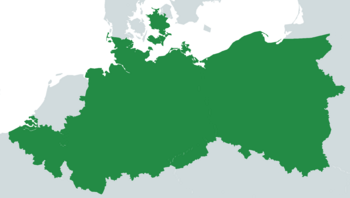Carrelie
This article is incomplete because it is pending further input from participants, or it is a work-in-progress by one author. Please comment on this article's talk page to share your input, comments and questions. Note: To contribute to this article, you may need to seek help from the author(s) of this page. |
Carrelian Empire Empire Carrelien | |
|---|---|
| Motto: 'Onfeïtebe Épaneit' Forever Infallible | |
| Anthem: 'Ve Mase oú Canerila' Royal anthem: 'Ńoúte-Damme oú Canerila' | |
 Carrelie in Western Europe | |
| Capital | Mont-Sanguine |
| Largest city | Haufenburg |
| Official languages |
|
| Recognised regional languages |
|
| Demonym(s) | Carrelian |
| Government | Federal Parliamentary Semi-Constitutional Elective Monarchy |
• Monarch | Edith-Marie |
• Speaker of the Lords | Queen Elysabet of Arianos |
• Captain-Regent | Marien Béië-Kawne |
| Legislature | Councils of Governance |
| Lords' Council | |
| Commons Council | |
| Formation | |
• Union of the Empire | 1 May 1570 |
• Federation | 1 February 1644 |
• Carrelian Civil War | 30 June 1861 - 4 June 1874 |
• Dentrician Revolution | 27 April 2013 |
| Population | |
• 2020 estimate | 754,187,200 (3rd) |
• 2012 census | 751,454,271 |
• Density | 270.7/km2 (701.1/sq mi) (50th) |
| GDP (PPP) | 2020 estimate |
• Total | 5.24 trillion (4th) |
• Per capita | 61,816 (8th) |
| GDP (nominal) | 2020 estimate |
• Total | $3.78 trillion (4th) |
• Per capita | 63,051 (5th) |
| Gini (2019) | 29.7 low |
| HDI (2019) | very high (6th) |
| Currency | Valire (₴) (VLR) |
| Time zone | UTC+0 - +2 (CGT, MCT, AMT) |
| Date format | dd/mm/yyyy (AD) |
| Driving side | left |
| Calling code | +49 |
| ISO 3166 code | CL |
| Internet TLD | .ce |
Carrelie, officially the Carrelian Empire, is a country in Europe. It borders the English Channel and the North Sea in the west and the Baltic Sea in the east. It is bordered by the Netherlands, Luxembourg and France to the west; Germany, Czechia and Slovakia to the south; Ukraine to the southeast and Lithuania and Belarus to the east.
Various tribes have inhabited the area now known as Carrelie since antiquity. The first recorded tribe to have inhabited the area is the Caisecawer, the direct ancestor of the modern Iffrws. The region was first united in the 970s, when Petty King Gosanric of Kuris conquered the Hasvet kingdoms neighbouring his domain, declaring himself High King. This kingdom collapsed after the death of Covrin the Unfortunate, only to be restored 23 years later by Count Edward Claes of Haufenburg in 1127. This line would later form the empire under Frederick the Victorious and stretch Carrelie to its current borders.
Today, Carrelie is a semi-constitutional federal elective monarchy. It is comprised of 11 autonomous nations, including 1 city-state, and 5 overseas territories. These are further divided into administrative divisions, such as Achanor's counties and Douria's lordships. Each of these nations are led by their own head of state and head of government, with their own legislature. However, these legislatures all report to the Councils of Governance in Mont-Sanguine.
Etymology
Carrelie's English name comes from the word for the region in old Dentrician, Kërelï. During the 12th century, this word was adopted by the Kings of Haufenburg-Kause as Karelia, which would later become Karelie. Previously, Carelie was most often used to refer to the country in English, though after 1986 this spelling was phased out in favour as Carrelie.
History
Before the Carrelian Empire
Formation of the Carelian Empire
Federation & Civil War
World Wars
Poland Crisis & the National Restoration Junta
21st Century
Geography
Carrelie is the second-largest country in Europe, behind Russia, and borders the Netherlands, Luxembourg and France to the west, Denmark and Russia to the north and northeast, Waisnor and Ukraine to the east and Czechia, Slovakia and Germany to the south. It also borders the North and Baltic Seas in the north. Carrelie's territory in Europe is its most expansive and is often referred to as Federal Carrelie due to its many autonomous nations.

